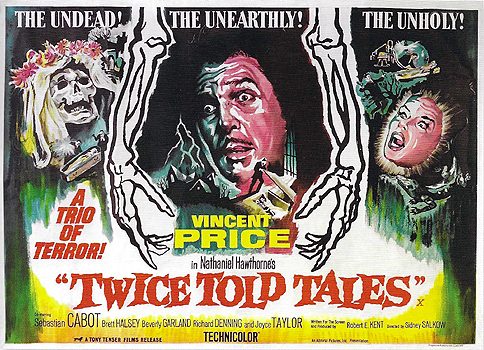 Twice-Told Tales / Nights of Terror (1963) **
Twice-Told Tales / Nights of Terror (1963) **
The year after the release of Tales of Terror/Poe’s Tales of Terror, MGM attempted to do for Nathaniel Hawthorne what AIP had been doing for Poe since 1960’s The Fall of the House of Usher. The result, Twice-Told Tales/Nights of Terror is, as much as anything else, a striking illustration of why AIP was America’s premier exploitation studio during the 1960’s, and MGM was not.
Like Tales of Terror, Twice-Told Tales is a three-part anthology in which the lead role in each story is played by Vincent Price. The first is “Dr. Heidegger’s Experiment,” in which Price plays an old man named Alex Medbourne (and by the way, the makeup artists here were spot-on in their prediction of what Price was going to look like in his late 70’s), who has come to visit his old friend, Dr. Carl Heidegger (The Time Machine’s Sebastian Cabot), on his 79th birthday. While the two men talk, it comes out that Heidegger has spent damn near his entire life pining away for a woman named Sylvia, whom he was prevented from marrying when she died of a sudden illness on the eve of their wedding day. Birthdays at the Heidegger place are a rather morbid affair, given that they always end with the doctor leaning out his parlor window to drink a toast in the direction of his fiancee’s crypt. On this night, though, it happens that there is a fierce thunderstorm raging, and the moment Heidegger finishes toasting Sylvia, a bolt of lightning strikes the mausoleum, blasting the door from its hinges.
Heidegger and Medbourne go to assess the damage as soon as the storm subsides, and they find some extraordinary things inside the crypt. The shock of the lightning strike knocked Sylvia’s coffin off of its pedestal and jarred its lid out of place, revealing a most amazing sight. Sylvia (Mari Blanchard, from She Devil and Son of Sinbad) hasn’t decayed in the slightest in all the 40-some years she’s spent in that casket. Stranger still, it seems that the cause of this incredible anomaly lies in the water that has been steadily dripping onto— and into— her coffin from a hairline fissure in the crypt’s ceiling; apparently the earth above it contains some hitherto unknown chemical with the power to stop organic corruption in its tracks. Heidegger collects a jarful of this remarkable water, and begins experimenting with it. First, he drips some on a dried rose, which instantly regains the freshness it had when it was first cut. Encouraged, Heidegger drinks some of the water, and to his delight, finds himself looking into the mirror at the face of a man in his mid-40’s. Heidegger insists that his friend try his newly discovered elixir of life, too, and Alex obliges him, with identical results. Finally, the doctor hits upon the idea of using the water from the crypt in an attempt to revive Sylvia. After all, if being bathed in it a drop at a time for 40 years could keep her corpse in perfect preservation, perhaps a good, stiff belt of the stuff could bring her back to life. Indeed it does, but because this is a horror movie, there just has to be a catch. And as we shall soon learn, the relationships between the three old friends were far more complicated— and potentially far more dangerous for everyone involved— than Heidegger ever realized...
The second story, “Rappaccini’s Daughter,” is the best of the three. A young man named Giovanni Guasconti (Brett Halsey, from Return of the Fly and Luigi Cozzi’s The Black Cat) comes to Padua from Naples to study medicine under the renowned Professor Pietro Baglioni (Abraham Sofaer, of The Naked Jungle and Journey to the Center of Time). Shortly after moving into his new apartment, Guasconti sees a beautiful girl (Joyce Taylor, from 13 Frightened Girls and Atlantis, the Lost Continent) in the courtyard garden of the place next door. His landlady, Lisabetta (Edith Evanson, who played similarly tiny roles in Journey to the Center of the Earth and The Day the Earth Stood Still), will tell him nothing about the girl, however, beyond that her name is Beatrice Rappaccini, and that, if he knows what’s good for him, he’ll stay well clear of her.
Professor Baglioni gives Giovanni much the same advice about Beatrice when his pupil comes to him seeking advice, but at least the professor is more forthcoming with information about her background. Her father (Vincent Price) was once one of the foremost scientists in all of Italy. But Rappaccini’s wife deserted him shortly after Beatrice was born, and the man has never been the same since. He has withdrawn almost completely, not just from the scientific world, but from human society in general, seeing no one but his daughter— of whom one suspects he is almost insanely jealous.
Baglioni doesn’t know the half of it. The next several scenes make it clear that Rappaccini’s resentment of his faithless wife has led him to take some radical steps in Beatrice’s upbringing. From a very early age, he has injected her with an acidic poison from a rare plant he keeps in the garden, with the result that, after some 20 years, Beatrice’s touch means instant death. That way, she’ll neither have the ability to betray anyone the way her mother betrayed Rappaccini, nor will she ever have to experience such betrayal herself. Of course, it never occurred to Rappaccini to ask his daughter how she felt about his little scheme, and the fact of the matter is, she thinks it’s every bit as fucked up as we do. It also tends to complicate matters for Giovanni, who finds himself in love with a human Superfund candidate. Guasconti’s natural inclination is to call in Baglioni to set things straight with his vast scientific knowledge, but Rappaccini, once he hears about the new man in his daughter’s life, comes up with a plan, too. And though Rappaccini’s idea will probably prove more practical than Baglioni’s, Giovanni and Beatrice aren’t going to like it very much...
Finally, we have “The House of the Seven Gables.” (Incidentally, the movie’s title is right on the money when it comes to this story. Given that Price had already appeared in a film version of Hawthorne’s second-most-famous novel back in 1940, this is a Twice-Told Tale indeed.) This time, Price plays Gerald Pyncheon, a man whose family roots sink deep into New England history. Gerald and his wife, Alice (Beverly Garland, from Not of This Earth and It Conquered the World), arrive at the house of the title, where Gerald’s sister, Hannah (Jacqueline De Wit, whom you’ll almost surely fail to notice in The Leopard Man), lives. This house has been in the family for three generations, but before that, the land it was built on belonged to another family, the Maulles. Gerald’s grandfather had been a major player in the Salem witch scare of 1692, and when Matthew Maulle was convicted of witchcraft on the basis of Pyncheon’s accusation, the land on which the house now stands was confiscated from the “warlock’s” family, and transferred to his accuser’s. But, as is usually the case with such things, the Pyncheon family has been accursed ever since, and the last two Pyncheon males have died in the house, choking to death on their own blood.
Gerald’s reasons for returning to the old homestead are similarly time-honored. Legend has it that a great treasure lies hidden in a secret vault somewhere in the house. Hannah has been looking for the thing for years with no success whatsoever, but Gerald thinks he’s found the answer. He arranges to meet with Jonathan Maulle (Richard Denning, from The Black Scorpion and Target Earth), a descendant of Matthew’s who might be expected to know the secret of the hidden vault, as the house was built to plans drawn up by a Maulle.
Strange things start happening the moment the travelers arrive. Alice finds that she knows things about the house and its history that she couldn’t possibly have learned through normal channels. Doors open and close by themselves, small objects float about through the air, and mysterious cold spots appear and disappear all throughout the house. Most importantly, something seems to enter Alice’s body periodically, possessing her just long enough to give her a good scare. When Maulle arrives at the house, clues to the nature of these peculiar events begin to emerge. Specifically, it starts to look as though Alice and Jonathan are reincarnations of Matthew Maulle and his lover, who was also executed for witchcraft.
Jonathan, for his part, has no inclination to cooperate with Gerald; their families have been feuding for 150 years, and Jonathan sees no reason to end that feud so that the Pyncheons can further enrich themselves at Maulle expense. But oddly enough, it looks as though the ghosts inhabiting the House of the Seven Gables actually want Gerald and Hannah to find the hidden vault. Maybe it doesn’t really contain what Gerald thinks it does...
Anthology movies are always tricky; it’s tough enough to come up with one worthwhile screenplay, so what are the odds of any one team of writers putting together three or four at once? But the primary defect in Twice-Told Tales is one that I don’t think I’ve ever seen before— each story is, at roughly 45 minutes, much too long. At that point, it really makes more sense to invest in a little more character development and a subplot or two, and just release each segment as its own free-standing movie. “Rappaccini’s Daughter,” in particular, would have benefited from such treatment. As it stands, a half-hour’s worth of story infrastructure is being asked to support an extra fifteen minutes, leaving each story feeling underdeveloped and draggy. Then on top of that, director Sidney Salkow handles the movie— which is obviously supposed to be a horror film— as though it were a straight-up period melodrama. It’s as though he were too intimidated by Hawthorne’s reputation to try for any real scares, like such things were beneath the author of The Scarlet Letter. Good casting is responsible for salvaging some degree of entertainment value, with Vincent Price and Sebastian Cabot making for an especially good team in the first story. But I repeatedly found myself wishing that the Corman-Matheson team from AIP’s Poe movies had tackled this project instead of Salkow; those two would have known what to do with these stories.
Home Alphabetical Index Chronological Index Contact

